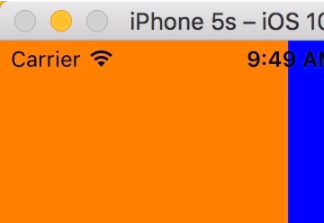看直播的童鞋们应该会经常看到满屏幕的滚动弹幕,看到密密麻麻的弹幕第一印象就是怎么样高效加载来避免卡顿,弹幕组成部分包含用户头像、用户昵称、弹幕的内容、表情等,本文介绍的实现原理就是把这几部分绘制成一张图片,然后通过定时器移动弹幕图片,当图片不在屏幕范围内即销毁。
先看下效果


下面我会详细介绍下实现原理
1 .获取弹幕数据来源,因为我是模拟生成弹幕,弹幕的数据存放在工程里的plist文件中

emotions存放这条弹幕的表情,type表示是否是自己发的,text表示弹幕内容,username表示用户昵称。取出plist文件的数据并转换成model。
|
1
2
3
4
5
6
7
8
9
10
11
12
13
14
|
#pragma mark - 获取数据源- (void)loaddata{ // 获取plist全路径 nsstring *filepath = [[nsbundle mainbundle] pathforresource:@"barrage.plist" oftype:nil]; // 从指定的路径中加载数据 nsarray *array = [nsarray arraywithcontentsoffile:filepath]; // 遍历数组 for (nsdictionary *dict in array) { // 字典转模型 bamodle *barragem = [bamodle barragewithdict:dict]; [self.danmus addobject:barragem]; }} |
2 .根据模型生成弹幕图片,通过点击屏幕生成模型,根据模型绘制图片。
|
1
2
3
4
5
6
7
8
9
10
11
12
13
14
15
|
#pragma mark - 触摸屏幕响应事件- (void)touchesbegan:(nsset<uitouch *> *)touches withevent:(uievent *)event{ // 获得一个随机整数 nsinteger index = arc4random_uniform((u_int32_t)self.danmus.count); // 获得一个随机模型 bamodle *danmu = self.danmus[index]; // 根据模型生成图片 baimage *image = [self.danmuview imagewithbarrage:danmu]; // 调整弹幕加载区域 image.x = self.view.bounds.size.width; image.y = arc4random_uniform(self.danmuview.bounds.size.height - image.size.height); // 把图片加到弹幕view上 [self.danmuview addimage:image]; } |
下面是具体绘制弹幕图片过程,我先简单介绍下,首先在绘图之前要确定上下文的尺寸,相当于画板的大小,画板的长 = 头像的长 + 昵称的长 + 内容的长 + 表情的长 * 表情个数 + 间距。然后就是分别绘制背景图片,用户昵称,内容和表情,最后返回一张图片。
此处有两点需要注意:
1.由于头像是矩形,想显示成圆形,要先画一个圆,并设置超出圆形的部分要裁剪,再绘制头像。
2.由于上面设置超出圆形的部分要裁剪,那即将要绘制背景岂不是要被裁剪,所以在绘制圆形区域上一句执行了cgcontextsavegstate(ctx)表示复制了一份画板(上下文)存到栈里,在绘制背景图片之前执行cgcontextrestoregstate(ctx),表示用之前保存的画板替换当前的,因为之前保存的画板没有设置超出圆形区域要裁剪的需求,当然替换当前的画板,会把当前画板上的绘图也copy过去。
|
1
2
3
4
5
6
7
8
9
10
11
12
13
14
15
16
17
18
19
20
21
22
23
24
25
26
27
28
29
30
31
32
33
34
35
36
37
38
39
40
41
42
43
44
45
46
47
48
49
50
51
52
53
54
55
56
57
58
59
60
61
62
63
64
65
66
67
68
69
70
71
72
73
74
|
#pragma mark - 绘制弹幕图片- (baimage *)imagewithbarrage:(bamodle *)danmu{ // 开启绘图上下文 // uifont *font = [uifont systemfontofsize:13]; // 头像 cgfloat iconh = 30; cgfloat iconw = iconh; // 间距 cgfloat marginx = 5; // 表情的尺寸 cgfloat emotionw = 25; cgfloat emotionh = emotionw; // 计算用户名占据的区域 cgsize namesize = [danmu.username boundingrectwithsize:cgsizemake(maxfloat, maxfloat) options:nsstringdrawinguseslinefragmentorigin attributes:@{nsfontattributename:font} context:nil].size; // 计算内容占据的区域 cgsize textsize = [danmu.text boundingrectwithsize:cgsizemake(maxfloat, maxfloat) options:nsstringdrawinguseslinefragmentorigin attributes:@{nsfontattributename:font} context:nil].size; // 位图上下文的尺寸 cgfloat contenth = iconh; cgfloat contentw = iconw + 4 * marginx + namesize.width + textsize.width + danmu.emotions.count * emotionh; cgsize contextsize = cgsizemake(contentw, contenth); uigraphicsbeginimagecontextwithoptions(contextsize, no, 0.0); // 获得位图上下文 cgcontextref ctx = uigraphicsgetcurrentcontext(); // 将上下文保存到栈中 cgcontextsavegstate(ctx); // 1.绘制圆形区域 cgrect iconframe = cgrectmake(0, 0, iconw, iconh); // 绘制头像圆形 cgcontextaddellipseinrect(ctx, iconframe); // 超出圆形的要裁剪 cgcontextclip(ctx); // 2.绘制头像 uiimage *icon = danmu.type ? [uiimage imagenamed:@"headimage_1"]:[uiimage imagenamed:@"headimage_2"]; [icon drawinrect:iconframe]; // 将上下文出栈替换当前上下文 cgcontextrestoregstate(ctx); // 3.绘制背景图片 cgfloat bgx = iconw + marginx; cgfloat bgy = 0; cgfloat bgw = contentw - bgx; cgfloat bgh = contenth; danmu.type ? [[uicolor orangecolor] set]:[[uicolor whitecolor] set]; [[uibezierpath bezierpathwithroundedrect:cgrectmake(bgx, bgy, bgw, bgh) cornerradius:20.0] fill]; // 4.绘制用户名 cgfloat namex = bgx + marginx; cgfloat namey = (contenth - namesize.height) * 0.5; [danmu.username drawatpoint:cgpointmake(namex, namey) withattributes:@{nsattachmentattributename:font,nsforegroundcolorattributename:danmu.type == no ? [uicolor orangecolor]:[uicolor blackcolor]}]; // 5.绘制内容 cgfloat textx = namex + namesize.width + marginx; cgfloat texty = namey; [danmu.text drawatpoint:cgpointmake(textx, texty) withattributes:@{nsattachmentattributename:font,nsforegroundcolorattributename:danmu.type == no ? [uicolor blackcolor]:[uicolor whitecolor]}]; // 6.绘制表情 __block cgfloat emotionx = textx + textsize.width; cgfloat emotiony = (contenth - emotionh) * 0.5; [danmu.emotions enumerateobjectsusingblock:^(nsstring *emotionname, nsuinteger idx, bool * _nonnull stop) { // 加载表情图片 uiimage *emotion = [uiimage imagenamed:emotionname]; [emotion drawinrect:cgrectmake(emotionx, emotiony, emotionw, emotionh)]; // 修改emotionx emotionx += emotionw; }]; // 从位图上下文中获得绘制好的图片 uiimage *image = uigraphicsgetimagefromcurrentimagecontext(); return [[baimage alloc] initwithcgimage:image.cgimage scale:[uiscreen mainscreen].scale orientation:uiimageorientationup];} |
3 .开启绘图定时器,回调方法是setneedsdisplay,这样就会执行- (void)drawrect:(cgrect)rect每次修改image.x(由于uiimage没有x、y属性,所以写了个类拓展baimage),滚动不在屏幕范围内的会销毁
|
1
2
3
4
5
6
7
8
9
10
11
12
13
14
15
16
17
18
19
20
21
22
23
24
25
26
27
28
29
|
#pragma mark - 添加定时器- (void)addtimer{ if (self.link) { return; } // 每秒执行60次回调 cadisplaylink *link = [cadisplaylink displaylinkwithtarget:self selector:@selector(setneedsdisplay)]; // 将定时器添加到runloop [link addtorunloop:[nsrunloop currentrunloop] formode:nsrunloopcommonmodes]; self.link = link;}#pragma mark - 绘制移动- (void)drawrect:(cgrect)rect{ for (baimage *image in self.imagearray) { image.x -= 3; // 绘制图片 [image drawatpoint:cgpointmake(image.x, image.y)]; // 判断图片是否超出屏幕 if (image.x + image.size.width < 0) { [self.deleteimagearray addobject:image]; } } // 移除超过屏幕的弹幕 for (baimage *image in self.deleteimagearray) { [self.imagearray removeobject:image]; } [self.deleteimagearray removeallobjects];} |
最后附上代码地址:barragedemo.rar
以上就是本文的全部内容,希望对大家的学习有所帮助,也希望大家多多支持服务器之家。
原文链接:http://www.jianshu.com/p/be53cbf4590c


















